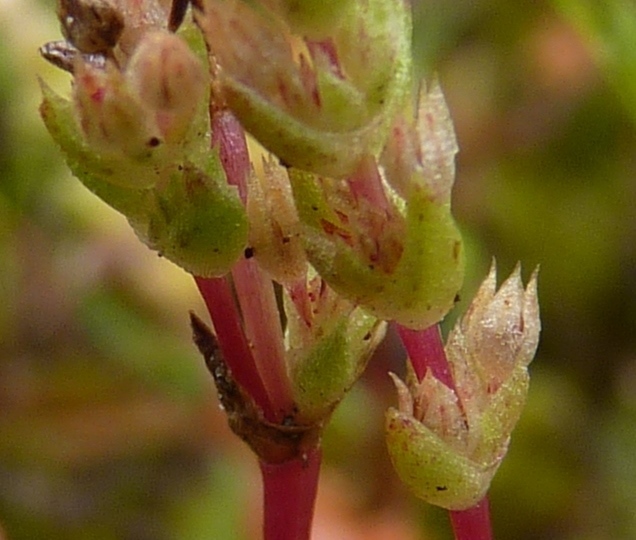Crassula sieberiana
(Schult. & Schult.f.) Druce Sieber CrassulaMostly annual or sometimes perennial with erect to decumbent branches to 20 cm long, more or less branched but mainly from the basal nodes. Leaves linear-lanceolate, 2.2–11 mm long, 0.8–3.6 mm wide, acute to obtuse, more or less flat above, often strongly convex below. Inflorescence 1–several spike-like thyrses with sessile cymules in axils of leaf-like bracts, often becoming pedicellate when fruiting. Flowers 4- or 5-merous; calyx-lobes linear-lanceolate, 1.5–3.3 mm long, acute and often pointed, usually erect in fruit; corolla cream tinged red, lobes lanceolate, 1–2 mm long, acuminate and often folded lengthwise; nectary scales linear-cuneate to almost T-shaped, 0.4–0.6 mm long, 0.1–0.3 mm wide, usually truncate; carpels conical, with 2 ovules. Follicles smooth to finely papillose, releasing seeds through apical pore or detaching basally from receptacle; seeds 0.4–0.6 mm long, almost smooth or with tubercles along longitudinal ridges. Flowers Sep.–Jun., depending on the rainy season.
LoM, MuM, Wim, GleP, Brid, VVP, VRiv, MSB, RobP, MuF, GipP, OtP, WaP, Gold, CVU, GGr, DunT, NIS, EGL, EGU, WPro, HSF, HNF, OtR, Strz, MonT, HFE, VAlp. Also SA, Qld, NSW, LHI, ACT, Tas. Grows on a wide range of substrates, but common on rock ledges and in crevices, and on seasonally inundated ground.
This species has recently been revised, with two new species described (see notes under Crassula tetramera and Crassula colligata). Both these taxa have previously been recognised as Crassula sieberiana subsp. tetramera Toelken.
Toelken, H.R. (2002). The annual taxa of the Crassula sieberiana complex in South Australia. The South Australian Naturalist 76 (1/2):4–13.
Toelken, H.R.; Jeanes, J.A.; Stajsic, V. (1996). Crassulaceae. In: Walsh, N.G.; Entwisle, T.J., Flora of Victoria Vol. 3, Dicotyledons Winteraceae to Myrtaceae, pp. 542–555. Inkata Press, Melbourne.
 Spinning
Spinning


